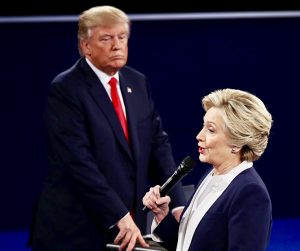
ST LOUIS, MO – OCTOBER 09: Democratic presidential nominee former Secretary of State Hillary Clinton (R) speaks as Republican presidential nominee Donald Trump looks on during the town hall debate at Washington University on October 9, 2016 in St Louis, Missouri. This is the second of three presidential debates scheduled prior to the November 8th election. (Photo by Win McNamee/Getty Images)
It is easy to be amused, appalled and disgusted by most of what Donald Trump has offered American voters in the first two US Presidential debates. However, it is equally easy to be disappointed by the absence of substance from Hillary Clinton. It is apparent that Hillary and her strategists feel that either no substantive answers are required to counter Trump’s incoherent perv-speak or that the format of the debates do not accommodate or reward a substantive answers. However, among the xenophobes, Nativists, anarchists and miscreants that make up the most disquieting portion of Trump’s base lie well-meaning Americans that have reacted both viscerally and reasonably to the kernel of truth that underlies his opaque critique of America’s role in the global economy.
On the assumption that it is the short answer bias of the debate format that has precluded Hillary from answering his screed, I challenged myself to come up with something pithy but substantive to answer the reasonable fears of average Americans that Trump has sought to exploit on the issue of global trade. Here it is (picture me in a fetching pant suit with my hair just so):
“Donald says few things that I understand let alone agree with, but there is one element of his rhetoric that touches on a true and legitimate concern of Americans. Something has indeed fundamentally changed for working class Americans over the last forty years. And that change is undeniably a consequence of the liberalization of global trade. That is not to say that free trade is bad. No government policy has contributed more to the rapid decrease in poverty around the globe and rising general prosperity in America. There is no reputable economist in the world and no measure of practical experience over the last forty years that can refute this fact. However, it is no less clear that the benefits of freer trade have not been realized simultaneously by each trade partner, and that the allocation of those benefits among members of specific groups in the economy have not been equitable.
It is this reality that presents the greatest challenge to those of us seeking to make and sustain the case for freer trade among nations. The benefits of free trade for advanced economies are by necessity deferred. As the world’s most advanced economy, America seeks free trade globally by offering access to its established consumer economy of 330 million people. In exchange, Americans gain access to economies of many multiples of that among nations that are only now developing a viable middle class. This new global middle class will ultimately unleash a vast untapped appetite for the kinds of consumer goods that we ceased to view as luxuries two generations ago, providing enormous new markets for American products. However, these benefits will be deferred. In the near term, free trade creates opportunities for capital and knowledge, resources with which America is uniquely blessed, and for low cost labour, with which emerging economies enjoy a profound competitive advantage.
This does not mean that all manufacturing will migrate from America. Our knowledge-based economy has created many productivity-enhancing technologies and a better educated work force that offset some of the competitive advantage otherwise available through lower wage rates. However, it is inevitable that some jobs will migrate as a consequence of the exchange of market access through free trade. Fortunately, over time, these effects will diminish, as rising prosperity in emerging markets drives the expectations of the working class to both increase the market for higher-value knowledge based goods and narrow the wage gap.
Therein lies the challenge for policy makers. We must develop policies that recognize and dampen theses inequities. The benefits of enhanced prosperity that accrue to American capital and knowledge must be redistributed through fair taxation that recognizes that their allocation owes as much to these policy choices as it does to the wealth and knowledge of the beneficiaries. We must create jobs in the renewal of our infrastructure that cannot be outsourced to low wage economies and will enhance productivity by making our cities more workable, our extraction industries more sustainable and our agriculture more efficient. We must reform our educational institutions and systems to make them more accessible to all Americans and maintain them as leaders in the global marketplace of ideas.
Freer trade does present challenges, but these are not challenges that can be addressed by walls, either physical or metaphorical. These challenges cannot be addressed by retreat, by the nurturing of unity in opposition to not only those beyond our borders but to the arc of progress itself. These challenges can only be met by owning up to the nature of the transformation, seizing upon the opportunities it offers and embracing a common commitment to make it work for all.”
Two minutes and 34 seconds; I timed it. A little over the two minutes that Hillary and Donald were granted for policy statements on issues, but well within the liberties that each of them took with that restriction in both debates. It is too much to hope that civility and substance will make a miraculous appearance at the final debate next Wednesday, but for the sake of those that truly want to hear something substantive that addresses real issues that divide Americans if not the candidates, let’s hope Hillary finds the opportunity to say something like this.


